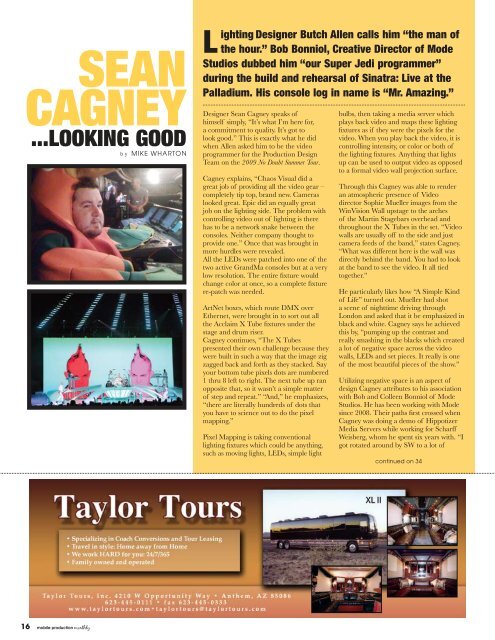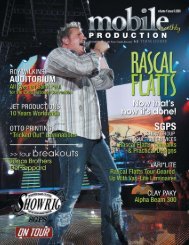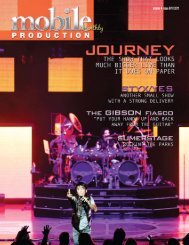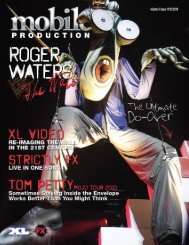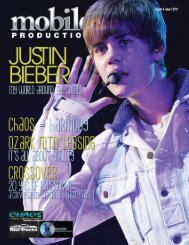volume 2 issue 8 2009 - Mobile Production Pro
volume 2 issue 8 2009 - Mobile Production Pro
volume 2 issue 8 2009 - Mobile Production Pro
You also want an ePaper? Increase the reach of your titles
YUMPU automatically turns print PDFs into web optimized ePapers that Google loves.
Sean<br />
Cagney<br />
...Looking Good<br />
by Mike Wharton<br />
Lighting Designer Butch Allen calls him “the man of<br />
the hour.” Bob Bonniol, Creative Director of Mode<br />
Studios dubbed him “our Super Jedi programmer”<br />
during the build and rehearsal of Sinatra: Live at the<br />
Palladium. His console log in name is “Mr. Amazing.”<br />
Designer Sean Cagney speaks of<br />
himself simply, “It’s what I’m here for,<br />
a commitment to quality. It’s got to<br />
look good.” This is exactly what he did<br />
when Allen asked him to be the video<br />
programmer for the <strong><strong>Pro</strong>duction</strong> Design<br />
Team on the <strong>2009</strong> No Doubt Summer Tour.<br />
Cagney explains, “Chaos Visual did a<br />
great job of providing all the video gear –<br />
completely tip top, brand new. Cameras<br />
looked great. Epic did an equally great<br />
job on the lighting side. The problem with<br />
controlling video out of lighting is there<br />
has to be a network snake between the<br />
consoles. Neither company thought to<br />
provide one.” Once that was brought in<br />
more hurdles were revealed.<br />
All the LEDs were patched into one of the<br />
two active GrandMa consoles but at a very<br />
low resolution. The entire fixture would<br />
change color at once, so a complete fixture<br />
re-patch was needed.<br />
ArtNet boxes, which route DMX over<br />
Ethernet, were brought in to sort out all<br />
the Acclaim X Tube fixtures under the<br />
stage and drum riser.<br />
Cagney continues, “The X Tubes<br />
presented their own challenge because they<br />
were built in such a way that the image zig<br />
zagged back and forth as they stacked. Say<br />
your bottom tube pixels dots are numbered<br />
1 thru 8 left to right. The next tube up ran<br />
opposite that, so it wasn’t a simple matter<br />
of step and repeat.” “And,” he emphasizes,<br />
“there are literally hundreds of dots that<br />
you have to science out to do the pixel<br />
mapping.”<br />
Pixel Mapping is taking conventional<br />
lighting fixtures which could be anything,<br />
such as moving lights, LEDs, simple light<br />
bulbs, then taking a media server which<br />
plays back video and maps these lighting<br />
fixtures as if they were the pixels for the<br />
video. When you play back the video, it is<br />
controlling intensity, or color or both of<br />
the lighting fixtures. Anything that lights<br />
up can be used to output video as opposed<br />
to a formal video wall projection surface.<br />
Through this Cagney was able to render<br />
an atmospheric presence of Video<br />
director Sophie Mueller images from the<br />
WinVision Wall upstage to the arches<br />
of the Martin Stagebars overhead and<br />
throughout the X Tubes in the set. “Video<br />
walls are usually off to the side and just<br />
camera feeds of the band,” states Cagney.<br />
“What was different here is the wall was<br />
directly behind the band. You had to look<br />
at the band to see the video. It all tied<br />
together.”<br />
He particularly likes how “A Simple Kind<br />
of Life” turned out. Mueller had shot<br />
a scene of nighttime driving through<br />
London and asked that it be emphasized in<br />
black and white. Cagney says he achieved<br />
this by, “pumping up the contrast and<br />
really smashing in the blacks which created<br />
a lot of negative space across the video<br />
walls, LEDs and set pieces. It really is one<br />
of the most beautiful pieces of the show.”<br />
Utilizing negative space is an aspect of<br />
design Cagney attributes to his association<br />
with Bob and Colleen Bonniol of Mode<br />
Studios. He has been working with Mode<br />
since 2008. Their paths first crossed when<br />
Cagney was doing a demo of Hippotizer<br />
Media Servers while working for Scharff<br />
Weisberg, whom he spent six years with. “I<br />
got rotated around by SW to a lot of<br />
continued on 34<br />
16 mobile production monthly


